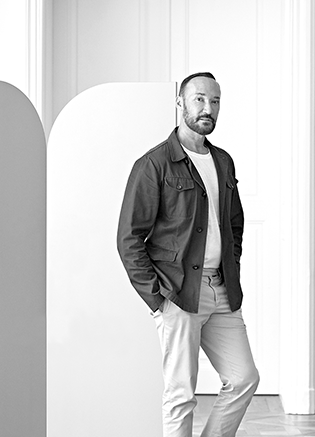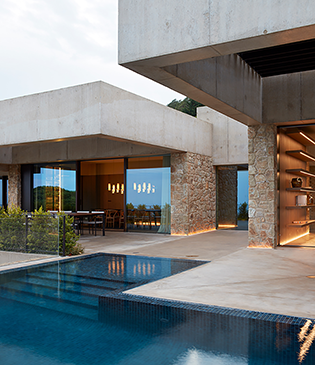At LZF, wood has been the staple of every lamp we have imagined, designed, and crafted. Enveloping light, our natural wood veneers shine with vitality and emanate warmth. In recent years, with a curious mind, we began exploring other materials, seeking new ways to complement our veneers. Glass was perhaps an obvious choice, however we were keen to probe the boundaries of what was possible with this medium.
Mariví Calvo, LZF’s co-founder and creative director, had been especially impressed in the glass designs created by Madrid-based Mayice, a product design and architecture studio. The studio’s Filamento Verticale light for example, is an exquisite piece of craftsmanship and sculpture. Mayice worked with Eduard Garuti, an accomplished glass-blowing artisan, to make the Filamento Verticale.
We knew at LZF that if we were to work with glass, crafting a glass and wood symbiosis, then we would work with Mayice, with hand-blown borosilicate glass, and with a master craftsman. Mayice set about designing several new glass and wood lamps for LZF, and in collaboration with Eduard Garuti, created Dune, Estela, and Eris. It is the first time we have married hand-blown glass with our wood veneer, and we are incredibly proud of the results.

Imanol Calderón Elósegui and Marta Alonso Yebra of Mayice
Here, Imanol Calderón Elósegui and Marta Alonso Yebra of Mayice, provide some insights to the new lamp designs and working with Eduard Garuti.
In Dune, Estela, and Eris, there is a perfect glass and wood symbiosis. How did you set out to achieve this?
(Mayice) Glass is a material that has been very important in our work during the past number of years. We love the principles of glass: its transparency, reflection, and refraction. We greatly admire the way in which craftsmen work with this material, using fire. The process is always hypnotic and magical. Throughout human history, glass has been used to encapsulate many objects, liquids, and light.

Estela.
Our aspiration was to create a double layer of glass that would contain LZF´s wood veneer. In the design of Dune, Estela, and Eris, LZF´s wood veneer takes the form of a cylinder. In each lamp, the wood is surrounded and protected by a transparent glass layer—with three different glass shapes, we create three individual atmospheres. The glass, wood, and technology, are crafted in Spain. We believe there is a dialogue between technology and craft, and find a perfect balance between light, glass, and wood.
Can you describe your relationship with the master glass-blower Eduard Garuti?
(Mayice) We greatly admire Eduard Garuti´s work and have learned much from him. He is a master, and with more than one hundred patents, a great inventor too. The designer Andreu Carulla introduced Eduard to us. We met Eduard in the spring of 2019, and have been working with him since then. We’ve spent time at his workshop, sharing ideas, and having many conversations about music, art, and life. His wife Ellen is an artist too, and an excellent chef. We’ve enjoyed unforgettable moments with both Ellen and Eduard, relishing exquisite cuisine and great conversation, in a perfect landscape between the mountains and sea.
Eduard produced Filamento Verticale, an extremely challenging and sculptural piece in glass that we designed. A single piece of glass, Filamento Verticale measures more than two meters in length. It is exhibited at the Rossana Orlandi Gallery in Milan.
You previously described Dune as ‘on the line between art and design’. What is that line—how do you differentiate between the two?
(Mayice) We think Dune is a lamp that sits between art and design. A high percentage of its production is crafted, but the process can be repeated. We define it as ‘crafted assembly line production’. The deformation that creates the special refraction effect is unique. It is produced by hand, and so every Dune lamp is a piece of art: each one is distinctive.
For us, Dune is a kind of art-design piece that is on the verge of art and design. Where are the limits? It is difficult to know, but it is a personal opinion.
Your work showcases a dialogue between craft and technology. With the increasing advance of technology in design and manufacturing, how do we ensure the preservation of craft?
(Mayice) We are still primitive creatures and need five senses to feel, so we need craft. Craft is in our work everyday. Craft allows us to improvise, and to innovate faster than technology. Craft gives soul to our work, creating unique pieces. Even if the pieces look the same, they are all different. Moreover, it is really important to work with master craftsmen, as there is a dialogue across the entire process. This way we are always learning, experiencing feelings, and making connections.
During this time, so many people have been isolated because of the coronavirus pandemic. Many people explain the feeling of needing their hands in order to work, to create things. This is most likely innate, and indeed it is therapeutic. The day that craft disappears, is the day when humans will become something else.


















